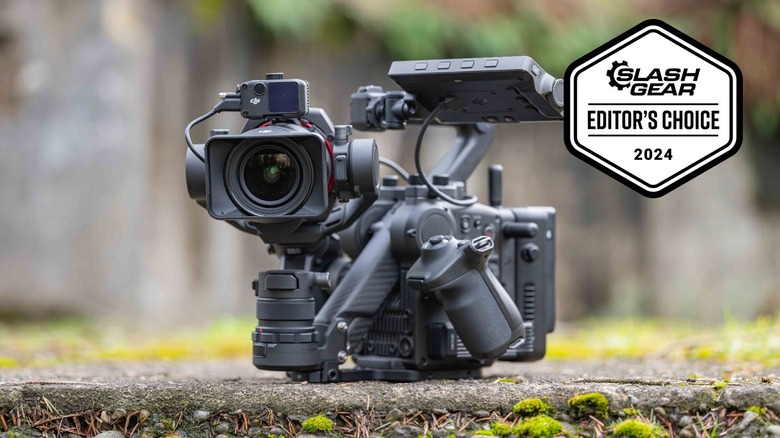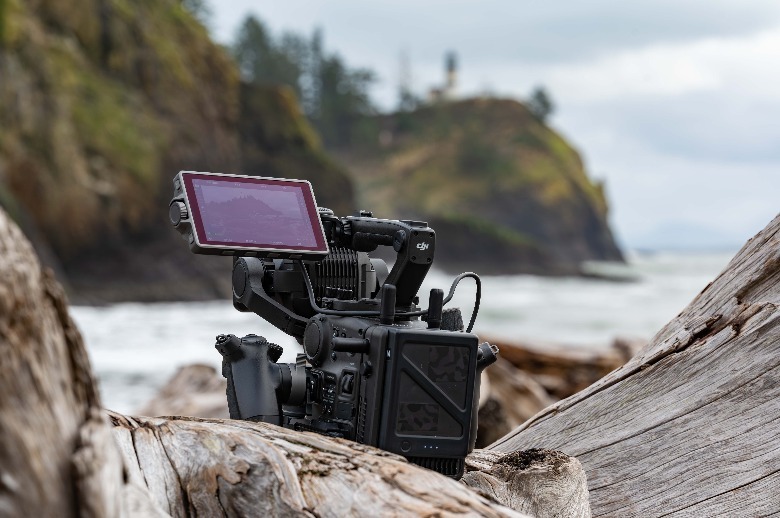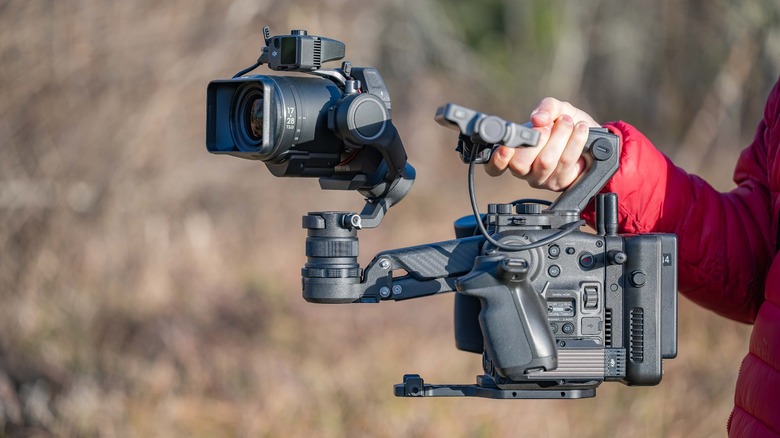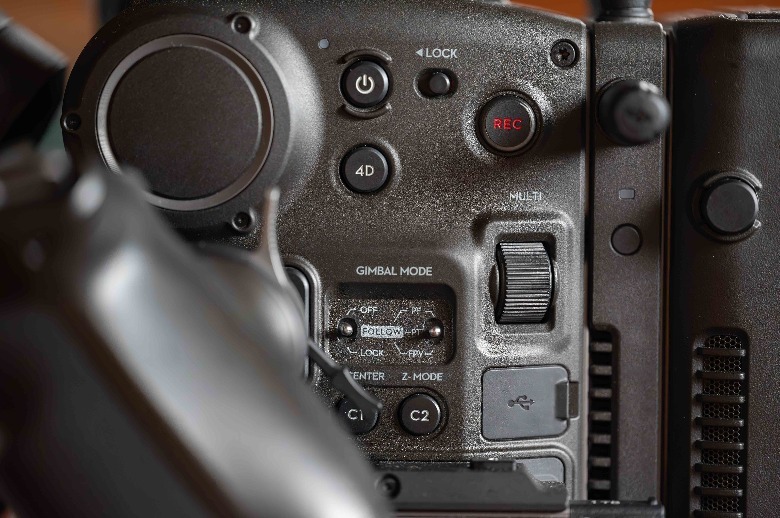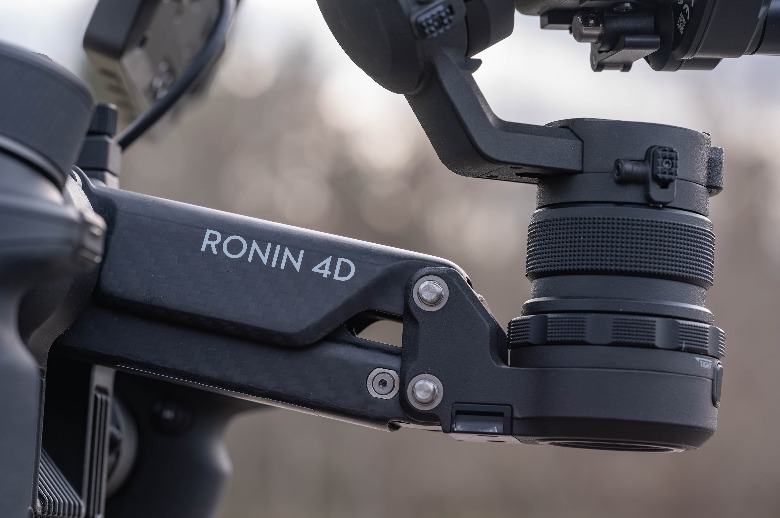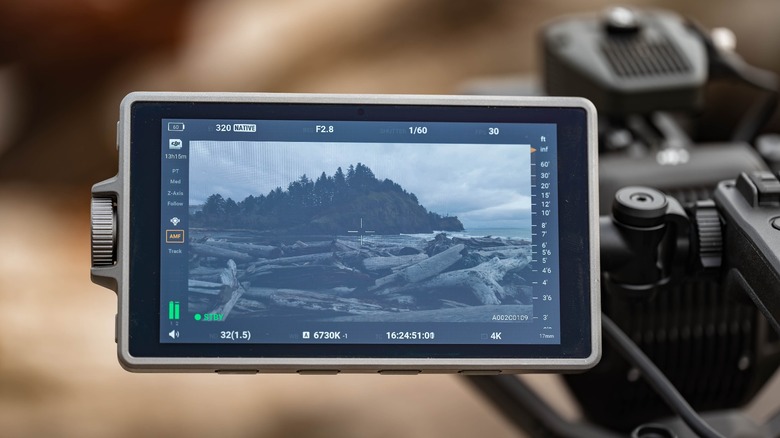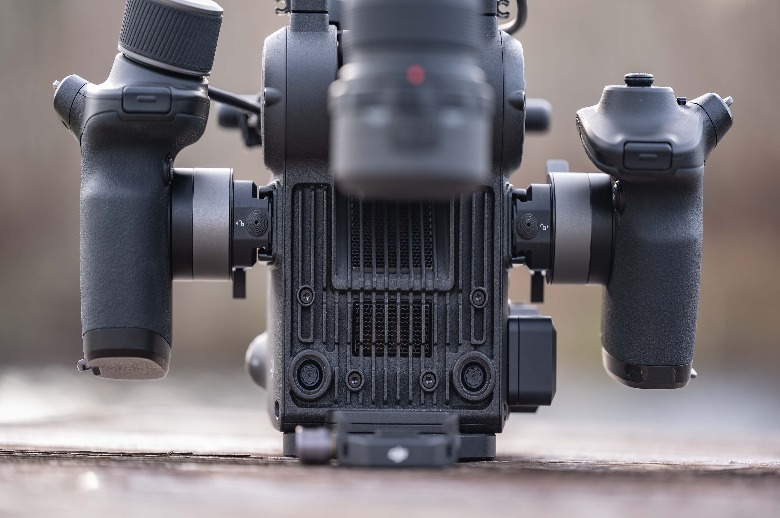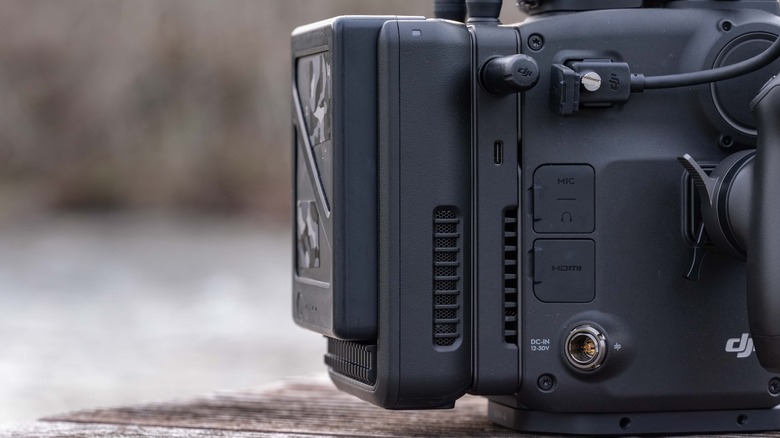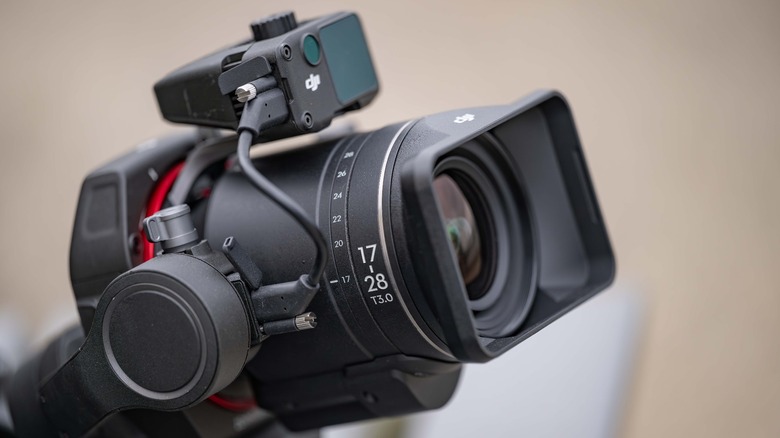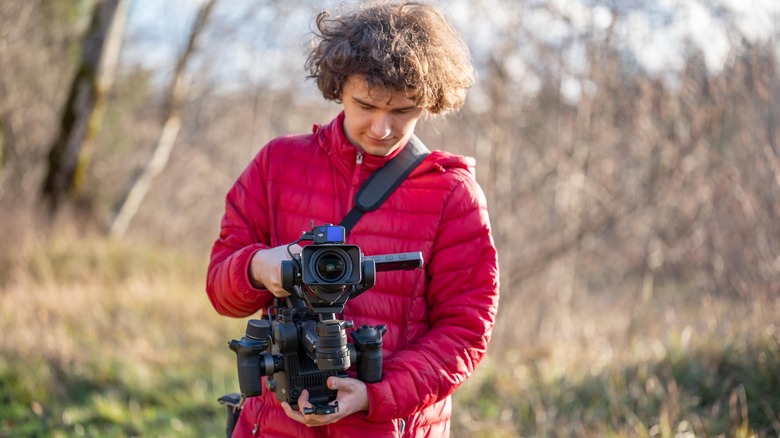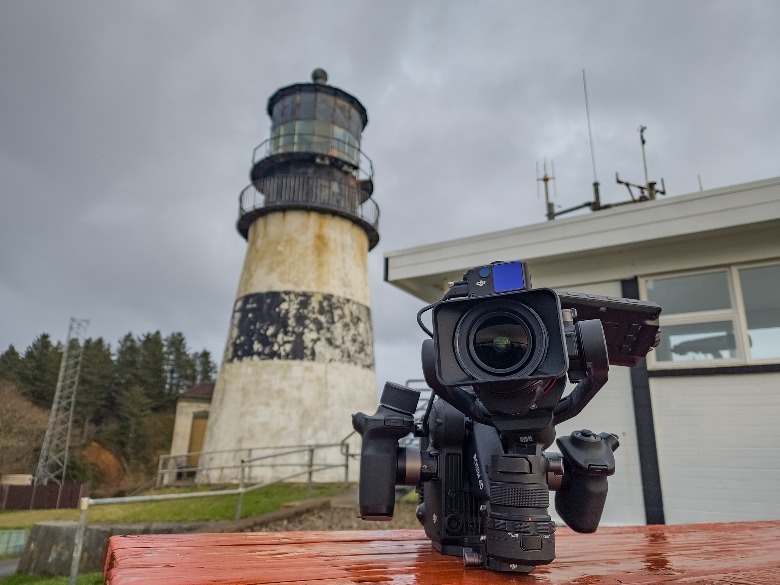DJI Ronin 4D-8K Review: The Ultimate All-In-One Cinema Camera
- Cinema-grade image quality
- Integrated 4-axis gimbal stabilization delivers amazing results
- Relatively affordable compared to other cinema cameras
- Integrated ND filters
- Apple ProRes RAW recording capability
- LiDar focus system
- Long range wireless remote monitoring system
- Good battery life
- Rock-solid build quality
- Costs almost as much as a new car
- Large and heavy
- Not water resistant
Capturing smooth, movie-quality footage can be a real challenge when you're operating without the advantages of a Hollywood budget, but the DJI Ronin 4D-8K might just be the ultimate solution to this conundrum. In addition to the typical 3-axis stabilization mechanism common to gimbal stabilizers, the Ronin 4D-8K adds a fourth axis which should help smooth out those pesky bumps in your footage incurred by walking or running.
As the name implies, the Ronin 4D-8K is capable of filming high-resolution 8K footage and has a whole bag of tricks under the hood which, at least on paper, makes this the perfect video creation tool for any filmmaker who can afford it. However, we have to take it out in the field and put the Ronin 4D-8K to the test to see if it lives up to the hype, and whether or not this is the camera for you.
DJI provided us with a sample of the DJI Ronin 4D-8K for this review.
Cinema quality video capture
It's quite impossible to say anything negative about the quality of video captured by the Ronin 4D-8K. You can shoot up to 8K 60fps in ProRes RAW format, or up to 4K 120fps and 8K 75fps in ProRes 422 HQ for slow motion, all using the entire full-frame sensor. A number of other file formats and crop options such as Super35 are also available, and we found the availability of the lightweight H.264 to be a convenient option, though we found that ProRes 422 HQ offered a nice middle ground for file size, dynamic range, and useability.
The Ronin 4D-8K features a dual native ISO of 320 and 1600, which can be expanded to a native 800 and 4000 ISO, alongside an increase of 12-bit to 14-bit recording when you engage Dynamic Range Expansion. In terms of low-light capabilities, the Ronin 4D-8K delivered excellent low-noise results, even when shooting at expanded ISO levels beyond the upper level of its dual native bases.
The DJI Cinema Color Science (DCCS) featured in the Ronin 4D-8K is excellent, and it's easy to grade the footage from this camera to achieve amazing results. The integrated ND filters were designed specifically to work with DCCS.
Between the great performance in low light, and the advantages of integrated neutral density filters during the day, paired with the high 14.7 stop dynamic range and the post-processing benefits of RAW recording, the DJI Ronin 4D-8K can deliver superb results in just about any circumstance.
Head-turning behemoth
There's nothing stealthy about the appearance of the Ronin 4D-8K, and in fact, this might be the most outlandish-looking camera you could possibly use. Whenever we were using it out in public, this bizarre contraption got plenty of stares from anyone we happened to encounter.
Like many cinema cameras, the Ronin 4D-8K is highly modular in its design, so you can use it in a variety of configurations. Handle controllers, monitor, battery, wireless transmission unit, top handle, baseplate, and even the gimbal/camera can be attached/detached. That detachable gimbal/camera unit is a big part of the appeal of this device, as it enables a great amount of future potential for upgradeability. You can kit the camera out with all its included (or additional) bells and whistles, or you can run it in a minimalist fashion.
At over 10 pounds fully assembled, the Ronin 4D-8K is a seriously heavy camera that can be seriously taxing to use for long shoots. Carrying it for a mile on a short hike with frequent stops for filming yielded some serious muscle knots later in the evening. It's also important to note that the camera is not water resistant, so keep an eye on the weather and plan to protect the Ronin 4D-8K from the elements. On the plus side, the Ronin 4D-8K comes in a really tough hard shell case of appropriate quality to protect such a high-value camera.
Silky smooth in any scenario
Using a typical 3-axis gimbal, you can't easily rid yourself of the tell-tail bumps from walking or running. The key reason the Ronin 4D-8K is so revolutionary is that it adds an additional fourth axis of powered stabilization, and the results are frankly magical. Even running flat out over uneven terrain we were able to achieve drone-like results, and thanks to the fast and accurate object tracking and autofocus system we were able to focus on our footing so that we didn't take a tumble and wreck $13,000 worth of camera gear.
The gimbal settings can be tweaked on a granular level, which combined with the customizable nature of ActiveTrack Pro and the various options for controlling focus, really allows you to dial in your shots when you need to. Automated Manual Focus (AMF) uses the dynamic damping system in the focus wheel on the right handgrip to create a hybrid system where camera operators can utilize both auto and manual focus simultaneously as the situation requires. This is further enhanced by a LiDAR system and accompanying graphical interface which enables you to achieve accurate manual focus on the fly.
The 4-axis stabilization, object tracking, and focusing system combine to create a uniquely fluid shooting experience that's intuitive while allowing for deep customization and control.
Built-in ND filters
A key feature that makes the Ronin 4D-8K so versatile and such a well-rounded cinema camera is its set of built-in neutral density (ND) filters. These range from ND.03 to ND2.7 (a total of 9 stops of exposure), which allowed us to maintain the necessary aperture and framerate even in bright outdoor situations. We didn't see a noticeable decline in image quality even when using the strongest available filter, and we found ourselves utilizing the ND filters for the majority of our shots using the camera.
Integrated neutral density filters are something we wish more cameras had, as they add another way to manipulate light, which is fundamentally what photography and videography are all about. This is true for both cameras intended for video or still capture, as ND filters are needed for shots where you want to blur the flow of water or traffic or use a wide aperture on a sunny day. It's going to be hard going back to cameras without integrated ND filters after a few weeks of shooting with the Ronin 4D-8K.
Big bright screen and excellent controls
The included 5.5–inch touchscreen display of the DJI Ronin 4D-8K represents one of the nicest interfaces we've ever used with a camera. It's color-accurate and bright enough for use even in harsh daylight. The size of it makes framing your shot easy, and the layout of menus combined with both touchscreen and physical navigation means you're never more than a few taps away from pretty much any setting.
This excellent screen and its user interface are paired with robust physical controls for gimbal operation on the main Ronin 4D body, along with further programmable controls on the left and right detachable controllers, both of which are adjustable to suit different grip styles. These can also be attached to the DJI High-Bright Remote Monitor so that one person can operate the Ronin 4D-8K while another carries the camera. This wireless transmission is effective at up to 20,000 feet.
Storage and power options
You have several options for storing data on the Ronin 4D-8K. The bundled 1TB ProSSD is necessary for recording RAW footage and provides plenty of onboard storage for the camera. It's important to note that the ProSSD needs to be removed and plugged directly into your device, as it cannot be accessed through the Ronin 4D-8K.
This caused us some confusion as the Ronin 4D-8K arrived pre-assembled and we weren't aware that the ProSSD was removable. Once DJI set us straight on how to transfer footage from the ProSSD we found that simply being able to plug the ProSSD into our PC via USB-C is quick and convenient. Alternatively, you can choose to record to an external device or utilize the integrated CFexpress Type-B port.
The Ronin 4D-8K accepts TB50 intelligent batteries, so if you already use the DJI Inspire 2 or Ronin 2 the batteries are cross-compatible. Each battery offers around 2.5 hours of recording time. The camera also features an AC adapter so that it can be plugged into an external power source.
Unparalleled lens compatibility
The standard DL mount of the Ronin 4D-8K features native support for lenses such as the excellent 24mm and 35mm f/2.8 DL prime lenses we tested with their extremely robust and ultra-lightweight carbon fiber construction. We spent most of our time using the versatile DL PZ 17-28mm T3.0 ASPH lens which features a power zoom system and is pretty much the perfect option to pair with this camera. DL lenses are also made to be used with the DJI Inspire 2, so if you already use that drone or plan to get it in the future, the shared compatibility of both lenses and batteries is really convenient.
What makes the Ronin 4D-8K really remarkable in terms of lens compatibility is the range of third-party lens mounts available for the system. These include Leica L and M mounts, Sony E, and ARRI PL. That makes available to you full compatibility with a vast library of glass from the budget-friendly to the ultra-high-end. To top it off, there's a wireless lens control system that enables remote manual and autofocus even on fully manual lenses.
Sky high price, but good value for the money
Sadly, for most people, the Ronin 4D-8K is well beyond what they can hope to afford. The whole kit will set you back $12,828, which for the sake of comparison is only about $3000 less than a brand new Nissan Versa. However, when you put that side-by-side with the recently announced RED V-Raptor [X] which starts at a whopping $29,995, you start to realize that within this space the Ronin 4D-8K exists on the "affordable" end of the spectrum. In fact, given how the Ronin 4D-8K includes a lens and everything else you need to start shooting, it could be considered something of a bargain, strange as that may be to say of a nearly $13,000 camera.
If you don't mind going back to DJI's previous generation camera and giving up a few upgrades, then the DJI Ronin 4D-6K only costs a remarkably reasonable $6,799. It needs to be noted that you'll still need a lens, which for a basic DJI DL PZ 17-28mm T3.0 ASPH lens will set you back a further $1,339. However, even with that taken into account, it's still a highly compelling option.
If you happen to already own the Ronin 4D-6K, then you have the option of upgrading to the 8K model by purchasing the camera module separately for $3,599. This upgradability is nice to have in a product like this.
Low budget alternatives
If you can't quite swing the cost of a Ronin 4D system, there are some good alternatives for those on a tight budget. DJI makes a line of excellent Ronin-branded camera gimbals, which we've put to good use in the past. These are available from as little as $279 for the Ronin SC, and run all the way up to $8,399 for the Ronin 2 Professional Combo. There are also good options available from other manufacturers such as Zhiyun and Tilta. Paired with something like the Blackmagic Cinema Camera 6K or the Nikon Z8, you can put together an effective system for less than $5,000.
With that said, you won't get the amazing image stabilization possible with the Ronin 4D-8K's 4-axis system, and you also won't benefit from integrated ND filters and all the other awesome features that make the Ronin 4D-8K such a force to be reckoned with.
If you're on a really tight budget or need something that's quicker to set up and is small enough to carry anywhere with you, then you should definitely consider the DJI Osmo Pocket 3. You're not going to be shooting feature films on it, but for many creators, it's the absolute ideal all-in-one system.
Conclusion
There's no doubt that the DJI Ronin 4D-8K is an incredible tool for professional video creators. It delivers fantastic high-resolution image quality and unparalleled video stabilization in a compact form factor, and there's really no reason you couldn't use this thing to record a feature film. From the average person's perspective, spending $12,828 on a camera would be insane, but in the market where the Ronin 4D-8K is competing, it's a compelling value.
Outside of movie makers, the Ronin 4D-8K may well appeal to wealthy online video creators looking to upgrade their production value. It's shockingly easy even for a novice operator to capture complex shots, so if money is no object then the only serious caveat is that it's big and heavy. You may want to add a gym membership to your cost calculations in preparation for operating it. In many ways, this is the ultimate all-in-one video camera, and if your pockets are deep enough we highly recommend it.
You can find the DJI Ronin 4D-8K available for sale in DJI's online store right now.
